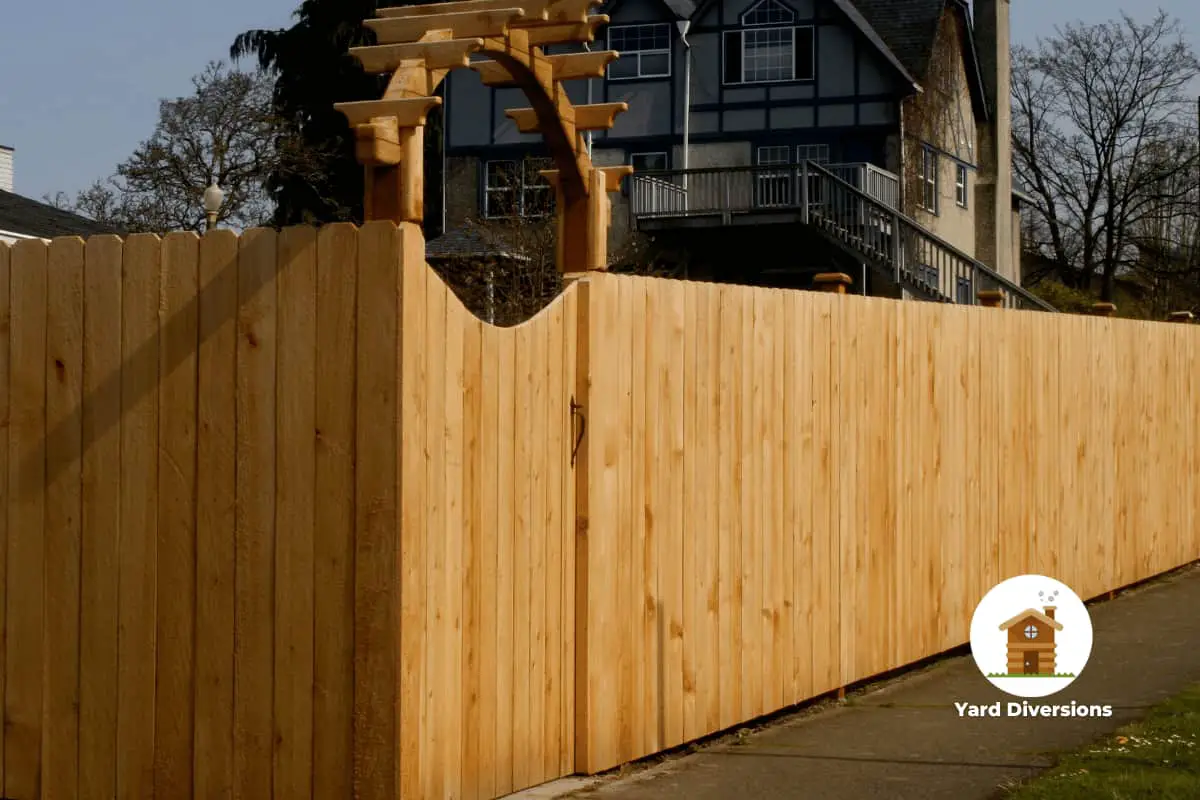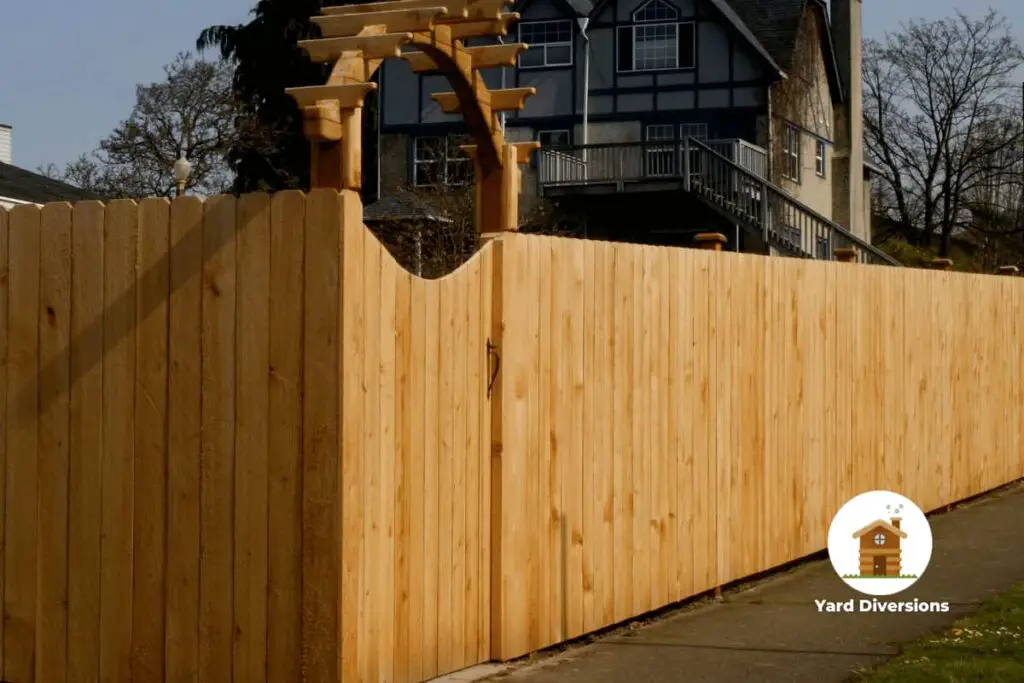When installing a privacy fence in your yard, you must make an important decision: which way should the fence face?
Knowing which direction to turn your fence can be the difference between having an effective barrier that keeps out prying eyes and one that does nothing more than look nice.
In this blog post, we’ll discuss which way is best for your privacy fence so you can ensure maximum security and peace of mind.

Assess Your Property and Landscape
A privacy fence can be a great way to create a sense of security and privacy in your yard. But before you start the installation process, it’s essential to make sure you know which way the fence should face.
It’s equally vital to assess your property and landscape to determine which way the fence should go.
Consider the layout of your yard, the direction of sunlight and wind, and the existing elements like trees, shrubs, and other structures.
These factors can help you choose the best way to orient your fence.
Consider the landscape and aesthetic needs
When planning the orientation of your fence, you’ll want to consider the aesthetic needs of your landscape.
Think about which way would be most attractive for the overall look of your yard. If trees or other large structures could interfere with the visibility and privacy created by your fence, it might be better to orient it in a different direction.
It would be best if you also considered which way will provide the most coverage and protection from the elements like sun, wind, and rain.
Think about privacy and security needs
A privacy fence can be a great solution when it comes to the security and privacy of your home and property.
However, before installing one, it is vital to assess your property and the surrounding landscape.
Consider the size of your yard, the type of terrain, and the neighboring structures. All these factors will determine the type and style of fencing best for you.
Additionally, take note of any trees, shrubs, or foliage that may be in the way or could obstruct your privacy fence in any way.
Doing so will help ensure you can effectively install your privacy fence without any issues.
Consider Solar Gain and Wind Patterns
When considering which way a privacy fence should face, it is essential also to consider the effects of solar gain and wind patterns in your area.
If you live in a location with warm summers, the sun will shine on your fence throughout the day.
Installing the fence facing the sun will help minimize heat absorption and make your outdoor space more comfortable.
Additionally, if you are in a windy area, installing the fence with the posts facing into the wind can help reduce the posts’ strain and provide extra support during inclement weather.
Be Mindful of Neighbors’ Views
When considering which way your privacy fence should face, it is wise to consider your neighbor’s views.
If your fence is tall enough to obstruct the view from their property, then you should think about the most pleasing way for them to look at it.
A solid panel fence may look better with the finished side facing outward, while a picket fence might look better with the posts and rails visible on the inside.
Regardless of choice, you should always check with your neighbor before installing to ensure they are okay with the placement of your fence.
Choose a Fence Material and Style
When choosing a fence material and style, there are a few things to remember. Privacy fencing is available in various materials and styles, so consider which will best suit your needs.
Popular materials for privacy fencing include:
- wood
- vinyl
- aluminum
- composite
Each of these materials comes in a variety of styles, such as picket fence, solid panel, louver, and lattice.
Additionally, you may want to consider the maintenance requirements for each type of material.
Wood fences require regular staining or painting to prevent rot and decay, while vinyl and aluminum fences require very little maintenance.
Your choice of fence material and style will depend on your individual needs.
Understand Local Building Codes and Regulations
You need to know the varied regulations applicable in your area. Most local and state building codes dictate the height of a fence, which side should face the property line, and other guidelines which must be followed when installing a privacy fence.
It is essential to research these rules before you begin any project to ensure your fence meets all necessary requirements.
Additionally, homeowners should ensure they are familiar with any HOA or other regulations which may apply in their area.
Check With Homeowners’ Associations or Neighborhood Covenants
Once you’ve settled on a fence style, material, and orientation, you must check with any homeowners’ associations or neighborhood covenants in your area.
Some communities have local rules regarding the type of fencing that can be used and the height it must be.
You should check with your homeowner’s insurance provider to discuss whether whatever fence you install is compliant with any policies you may already have.
Knowing the local regulations and insurance requirements will help ensure that your privacy fence meets all criteria.
Install Height Restrictors as Needed
When installing a privacy fence, you may need to add height restrictors for safety and security reasons.
Height restriction devices are designed to ensure that people can’t climb over your fencing and gain access to your property.
These devices should be installed on both sides of the fence by a qualified professional if they are required in your area.
Secure Your Privacy Fence with Locks and Latches
You want to ensure that your fence is secure from intruders, so you should install locks and latches on the gate.
This will prevent anyone from entering your property without permission and provide an extra layer of security for your home.
When choosing locks and latches, select ones that are durable enough to withstand anything that may come their way.
You can also increase security by installing motion-detecting lights or CCTV cameras around your privacy fence.
These measures will help deter unwelcome visitors before they have a chance to access your property.
Maintain Your Privacy Fence Regularly
Maintaining your privacy fence means working to keep it looking good, functioning correctly, and ensuring it lasts as long as possible.
Regularly check for signs of wear and tear, such as rotting wood or rusty nails, and inspect the fence line for any loose panels or posts.
Make sure to clear away any debris or vegetation growing against the fence.
Additionally, cleaning the fence periodically with a soft-bristled brush and mild detergent would be best to remove any dirt or grime.
Doing so will help your privacy fence look its best for years.
Choose Privacy Fencing Accessories and Decorative Elements
Once you have decided on your privacy fence’s style, material, and design, you can consider adding accessories and decorative elements.
Accessories, such as locks and latches, can provide an extra layer of security. Additionally, decorative elements can help the fence to blend in better with the rest of your landscape.
Many choices are available, including different colors, textures, and patterns.
Choosing the right accessories and decorative elements is a great way to customize your privacy fence and make it unique to your property.
Decide on a Design and Color Scheme
Once you have chosen the material, style, and orientation of your privacy fence, it’s time to decide on a design and color scheme.
There are many different options available for privacy fencing accessories and decorative elements.
You may add finials, caps, and post tops to make your fence look more finished. Or, you may choose to install lattice panels or decorative gates for added privacy and aesthetic appeal.
If you would like to add some color to your fence, you can select from various stain colors, paint colors, and even vinyl wraps to create a unique look that suits your home.
How Does the Design of Your Privacy Fence Impact the Functionality of Your Gate?
When it comes to privacy fence gating explained, the design of your fence can greatly impact the functionality of your gate. A well-designed fence can provide easy and smooth access, while a poorly designed one can cause issues with opening and closing. Consider the layout and materials of your fence to ensure seamless functionality.
Conclusion
In conclusion, there are many factors to consider when deciding which way your privacy fence should face.
It’s vital to think about many things to install a privacy fence correctly:
- assess your property and landscape
- consider aesthetic needs
- think about privacy and security needs
- take into account solar gain and wind patterns
- be mindful of neighbors’ views
- choose a fence material and style
- understand local building codes and regulations
- check with homeowners’ associations or neighborhood covenants
- install height restrictors as needed
- secure your privacy fence with locks and latches
- maintain your privacy fence regularly
- choose privacy fencing accessories and decorative elements
- decide on a design and color scheme.
All of these factors can help ensure that you make the best decision when deciding which way your privacy fence should face.
By following these guidelines, you can be sure that your fence is installed correctly and meets all local requirements.


